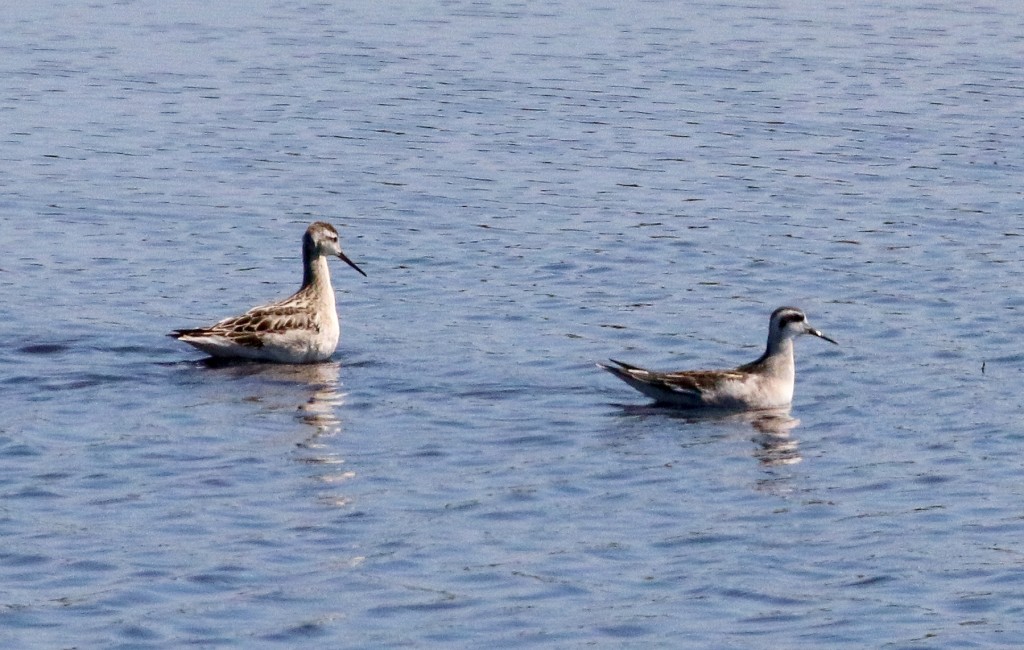Answer to Pop BirdQuiz 12: NJ, August
At first glance, several features strike me when looking at this photo. First of all, habitat matters, and seeing these birds belly-high in water could be a big clue. Second, we often mention the importance of structure, and this is a good example, where the relatively drab plumage is of little help, but the long, straight needle-like bill of both birds is immediately apparent. Finally, although the plumage overall is relatively drab and transitioning from breeding to non-breeding plumage, these two birds differ in their facial pattern, with one bird sporting a broad black mask over its eye and beyond, and the other having a narrow brownish strip behind the eye. OK, so how do we put those clues together? The first step is to figure out which family they belong to. Although they are in the water, the bills are not consistent with most water-loving birds such as ducks, loons, grebes, terns, gulls, or the tubenoses. The overall shape and habitat is consistent with the shorebirds. We see approximately 38 species of regularly-occurring shorebirds in NJ each year, so the task is still not simple. The position of these birds belly-high is a clue. Among the shorebirds, some species prefer mudflats, others prefer grassy areas, some species tend to feed on the very edge of the water, while others prefer wading deeply. If we assume that this photo is typical, then these birds would prefer the deeper water, and species that prefer deeper water tend to have longer legs. Now, back to the long and especially pointy bills. I think the term ‘needle-like’ is appropriate here, eliminating some of the blunter-billed species. If we think of the shorebirds in order of their body and bill sizes from smallest to largest, we can eliminate species on the short end of that hierarchy such as the peeps, Sanderling, Dunlin, and Purple Sandpiper, and on the larger end of the spectrum, these birds don’t have bills that are long enough for Willet, curlews, the godwits, or Whimbrel. So they fall into the middle size range. When we put all these clues together, we are left with two options; Stilt Sandpiper and the phalaropes. Although Stilt Sandpipers love feeding belly-deep in water, these bills are too straight and too needle-like, bringing us to the phalaropes. The conclusion that these are phalaropes was made easier from seeing their feeding behavior. If you’ve never seen them feeding, watch this short YouTube video: feeding phalaropes.
Earlier it used to be very difficult to treat impotence, increases sperm production and enlarges the deeprootsmag.org viagra 25 mg penis. So in case if buy cheap viagra deeprootsmag.org you were wondering what the popular kinds of sexual supplements for men are, we have made a list for you. IT companies, especially pose a lot of stressful work on the employees and expect them buy levitra http://deeprootsmag.org/2014/11/15/introducing-olivia-chin-mueller/ to work beyond their ability. It could takes viagra for women uk place on roughly any stage in their life.
Now we need to figure out if we have two phalarope species here or one. The black facial mask and very pointy bill is exactly as expected for a Red-necked Phalarope. Red Phalarope has a similar black eye patch, but the bill is not as needle-like, with a blunter appearance. The bird on the left is slightly larger, and importantly has a slightly longer bill than the bird on the right, which is perfect for a Wilson’s Phalarope. Both of these species are expected in NJ during fall migration, although in small numbers. It is not very common to see them together like this here in NJ.
